
VOLUME ONE
Color/B&W, 1947-54, 88m. / Directed by Kenneth Anger / Fantoma (US R1 NTSC)
VOLUME TWO
Color, 1964-81, 92m. / Directed by Kenneth Anger / Fantoma (US R1 NTSC)
Combined: BFI (Blu-ray & DVD) (UK R0 HD/PAL)
Though the jury may still be out on the most important American avant garde director of the past century, few can argue that the most influential is easily Kenneth Anger, 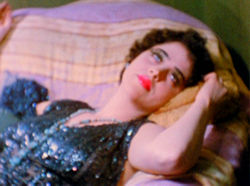 a pop culture alchemist who started out as a child actor, shocked the status quo with his audacious short films, and penned the scandalous Hollywood Babylon books. His most notorious film, "Scorpio Rising," encountered public legal battles over its sexual and blasphemous imagery, but all of his works are crammed with visual precision, a fine ear for found music, and plenty of cultural symbols ranging from occultism to classical theater. His vivid style can easily be seen as an influence on directors as diverse as Martin Scorsese, John Waters, Andy Warhol, Pedro Almodovar and Ken Russell, but watching the originals is still an unforgettable experience.
a pop culture alchemist who started out as a child actor, shocked the status quo with his audacious short films, and penned the scandalous Hollywood Babylon books. His most notorious film, "Scorpio Rising," encountered public legal battles over its sexual and blasphemous imagery, but all of his works are crammed with visual precision, a fine ear for found music, and plenty of cultural symbols ranging from occultism to classical theater. His vivid style can easily be seen as an influence on directors as diverse as Martin Scorsese, John Waters, Andy Warhol, Pedro Almodovar and Ken Russell, but watching the originals is still an unforgettable experience.
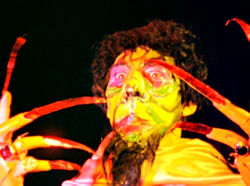 The first volume of Fantoma's essential Anger collection kicks off with one of his most acclaimed titles, "Fireworks," with the director himself starring as a soulful young man who encounters a surreal, dark wonderland filled with brutal Navy officers, incendiary genitalia, and a flying Christmas tree. Acknowledged as the first American film to openly deal with homosexuality, it also ruffled a few feathers with the military and became an instant favorite of the famous Dr. Alfred Kinsey, who became a frequent correspondent with Anger. Seen today it's still quite potent, and the image of Anger's abused face drenched in blood and, uh, milk can still make viewers gasp.
The first volume of Fantoma's essential Anger collection kicks off with one of his most acclaimed titles, "Fireworks," with the director himself starring as a soulful young man who encounters a surreal, dark wonderland filled with brutal Navy officers, incendiary genitalia, and a flying Christmas tree. Acknowledged as the first American film to openly deal with homosexuality, it also ruffled a few feathers with the military and became an instant favorite of the famous Dr. Alfred Kinsey, who became a frequent correspondent with Anger. Seen today it's still quite potent, and the image of Anger's abused face drenched in blood and, uh, milk can still make viewers gasp.
Two years later, Anger switched to color with the beautiful, non-narrative "Puce Moment," a six-minute mood piece which begins with a series of vividly colorful 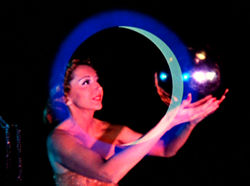 dresses shimmering past the camera. Then a baby-faced movie star (Anger's cousin, Yvonne Marquis) emerges and regards herself indulgently, then sprawls around outside in the Southern California hills. The film was originally intended to be much longer, but the only filmed fragments are still a visual treat and feature an effective psychedelic folk-rock piece by Jonathan Halper, added much later.
dresses shimmering past the camera. Then a baby-faced movie star (Anger's cousin, Yvonne Marquis) emerges and regards herself indulgently, then sprawls around outside in the Southern California hills. The film was originally intended to be much longer, but the only filmed fragments are still a visual treat and feature an effective psychedelic folk-rock piece by Jonathan Halper, added much later.
Anger is known for putting his films through several alterations over the years, but none has a more perplexing history than "Rabbit's Moon," which was shot in 1950 but never shown in any completed form until the 1970s. Shooting on 35mm for the first and only time (thanks to a film donation from some departing Russian filmmakers), Anger found himself in France working on a visual feast jumping off from the Eastern myth of a magical rabbit in the moon. Here that deity becomes the obsession of Pierrot, a mime alone in a magical forest whose doomed quest is complicated by the arrival of a harlequin, his beautiful princess companion, and a 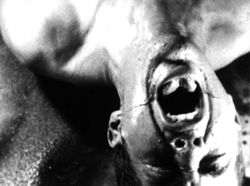 magic lantern which projects various arcane symbols. Sort of like Children of Paradise on acid, it's a deliberately stagey but richly rewarding piece for those willing to go along with its dreamlike logic. Anger originally prepared a 16-minute version of "Rabbit's Moon" in 1972 featuring a soundtrack of classic '50s doo-wop songs, but he later recut it to half its length in 1979 and replaced the soundtrack with a loop featuring the insanely catchy UK B-Side, "It Came in the Night" by A Raincoat. This latter version is the only one most viewers could see for years and appeared on various video compilations over the years. Here the earlier, longer version is presented for the first time, and the film itself benefits greatly from the expanded length. Also, the original tinting (mostly a ghostly blue with some brief injections of rose) is presented here more accurately, and a brief but jolting sound effect has been restored. While the vintage songs work just fine with the film, it's a bit odd seeing it without that great first theme most viewers have come to know and love (see Volume II below for more details).
magic lantern which projects various arcane symbols. Sort of like Children of Paradise on acid, it's a deliberately stagey but richly rewarding piece for those willing to go along with its dreamlike logic. Anger originally prepared a 16-minute version of "Rabbit's Moon" in 1972 featuring a soundtrack of classic '50s doo-wop songs, but he later recut it to half its length in 1979 and replaced the soundtrack with a loop featuring the insanely catchy UK B-Side, "It Came in the Night" by A Raincoat. This latter version is the only one most viewers could see for years and appeared on various video compilations over the years. Here the earlier, longer version is presented for the first time, and the film itself benefits greatly from the expanded length. Also, the original tinting (mostly a ghostly blue with some brief injections of rose) is presented here more accurately, and a brief but jolting sound effect has been restored. While the vintage songs work just fine with the film, it's a bit odd seeing it without that great first theme most viewers have come to know and love (see Volume II below for more details).
Next up is 1953's "Eaux d'Artifice," a 12-minute attempt to capture the tone of "water music" on film with Vivaldi music cascading on the soundtrack to beautiful, rhythmic shots of a water witch (played by a female midget recommended by Fellini!) walking through a nocturnal 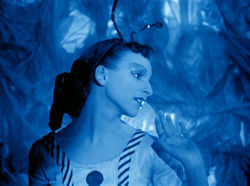 Italian garden and fading off into the swirling sheets of liquid. No story here, of course, but it's beautiful to watch.
Italian garden and fading off into the swirling sheets of liquid. No story here, of course, but it's beautiful to watch.
Finally, the first volume wraps up with the real monster of the set, 1954's half-hour cabalist phantasmagoria, "Inauguration of the Pleasure Dome." Orchestrated to Leos Janacek music, this invocation of the world of Aleister Crowley begins with a Dark Lord (Sampson De Brier) awakening, swallowing jewelry, and studying himself in a mirror, with the rest of the film following his transformation into a multi-colored beast among a colorful cast of characters including light-bringer Astarte (famous French erotica writer Ana´s Nin) and a Caligari-inspired slave (future horror director Curtis Harrington). Blindlingly colorful and utterly hallucinogenic, the film will either draw you under its spell or leave you scratching your head (perhaps both at once), but it's certainly impossible to dismiss. Once again Anger tinkering with various edits of the film over the years, but this final version is the only one currently surviving and seems just about perfect as it is.
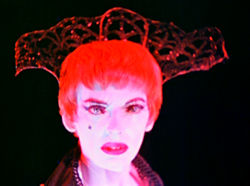 A long time coming, Fantoma's disc features much-needed new restored transfers of each film, and the increased clarity results in a more intense, rewarding experience than VHS could have ever provided. "Rabbit's Moon" is much sharper and more texturally dense than ever before, and "Inauguration" now bursts with pure, vividly-rendered reds which never translated well to home screens before. Kudos all around. Anger also contributes commentaries for each film, and he wisely avoids trying to spell out the meaning of anything (which should be a relief to film professors around the world who have been trying to decode these things for years). Instead he simply discusses the making of each, explaining the titles where necessary (now you can find out what the heck "Eaux d'Artifice" actually means) and pointing out how each participant was cast; for example, the sailors in "Fireworks" were real naval officers in their actual uniforms. Other extras include restoration demonstrations and a B&W reel of outtakes from "Rabbit's Moon," featuring test shots of the actors and various bits of business left out of the final cut. The disc comes packed in a slipcase featuring a thick booklet with an intro by Martin Scorsese, brief text notes on each film (with plenty of stills), and Ana´s Nin's diary memoir of making "Inauguration," in which she was originally supposed to be the main star but gradually found herself phased out in favor of other participants.
A long time coming, Fantoma's disc features much-needed new restored transfers of each film, and the increased clarity results in a more intense, rewarding experience than VHS could have ever provided. "Rabbit's Moon" is much sharper and more texturally dense than ever before, and "Inauguration" now bursts with pure, vividly-rendered reds which never translated well to home screens before. Kudos all around. Anger also contributes commentaries for each film, and he wisely avoids trying to spell out the meaning of anything (which should be a relief to film professors around the world who have been trying to decode these things for years). Instead he simply discusses the making of each, explaining the titles where necessary (now you can find out what the heck "Eaux d'Artifice" actually means) and pointing out how each participant was cast; for example, the sailors in "Fireworks" were real naval officers in their actual uniforms. Other extras include restoration demonstrations and a B&W reel of outtakes from "Rabbit's Moon," featuring test shots of the actors and various bits of business left out of the final cut. The disc comes packed in a slipcase featuring a thick booklet with an intro by Martin Scorsese, brief text notes on each film (with plenty of stills), and Ana´s Nin's diary memoir of making "Inauguration," in which she was originally supposed to be the main star but gradually found herself phased out in favor of other participants.
If Volume I lays the foundation for Anger's revolutionary techniques, Volume II is unquestionably the spectacular payoff. The disc kicks off with Anger's most famous and 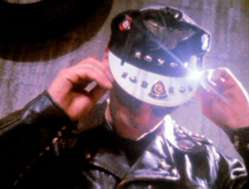 controversial film, 1964's "Scorpio Rising," a study of masculine fascination with sex and death as seen through American motorcyle culture. The half-hour film is broken into four sections, from a fetishistic study of a motorcycle's mechanics intercut with a biker getting ready for a night out, then to a study of rebel/delinquent hero worship, the biker's ball itself (containing some subliminal but graphic imagery that landed the film in court), and a dark, apocalyptic finale in which one of the cyclists was actually killed during filming. Featuring brief snippets of Marlon Brando and an amusing Jesus-oriented church film, it remains a striking example of personality-through-pop-culture on film and should also appeal to horror fans with its lurid, sinister climax. Though it remained an underground title, "Scorpio Rising" influenced many of the major filmmakers of the 1970s, most obviously Martin Scorsese, whose use of pop tunes as counterpoint was clearly driven by this film. Incidentally, the avalanche of Phil Spector tunes caused this film to disappear from video circulation for several years, but the original soundtrack is thankfully all here and accounted for on the DVD, sounding better than ever.
controversial film, 1964's "Scorpio Rising," a study of masculine fascination with sex and death as seen through American motorcyle culture. The half-hour film is broken into four sections, from a fetishistic study of a motorcycle's mechanics intercut with a biker getting ready for a night out, then to a study of rebel/delinquent hero worship, the biker's ball itself (containing some subliminal but graphic imagery that landed the film in court), and a dark, apocalyptic finale in which one of the cyclists was actually killed during filming. Featuring brief snippets of Marlon Brando and an amusing Jesus-oriented church film, it remains a striking example of personality-through-pop-culture on film and should also appeal to horror fans with its lurid, sinister climax. Though it remained an underground title, "Scorpio Rising" influenced many of the major filmmakers of the 1970s, most obviously Martin Scorsese, whose use of pop tunes as counterpoint was clearly driven by this film. Incidentally, the avalanche of Phil Spector tunes caused this film to disappear from video circulation for several years, but the original soundtrack is thankfully all here and accounted for on the DVD, sounding better than ever.
The following year saw the release of "Kustom Kar Kommandos," a 3-minute remnant of what was intended to be a much larger project about America's car fixation. Left unfinished due to the lead actor's death and a lack of funds, the film now exists as a hyper-saturated, pink-hued vignette with a T-shirt clad muscle guy buff-puffing his gleaming automobile to 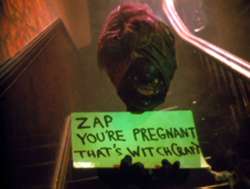 the strains of "Dream Lover." It's an amusing and beautiful distillation of the Anger style over the course of one song and would probably make a good intro for newcomers. Note that the film has always had a huge amount of in-camera jitter and flutter, though that has been minimized somewhat on this release. (Anger's original, full-length treatment for the project, entitled "Kustom," is also included in the liner notes.)
the strains of "Dream Lover." It's an amusing and beautiful distillation of the Anger style over the course of one song and would probably make a good intro for newcomers. Note that the film has always had a huge amount of in-camera jitter and flutter, though that has been minimized somewhat on this release. (Anger's original, full-length treatment for the project, entitled "Kustom," is also included in the liner notes.)
Unleashed near the end of the flower power era and easily the most unsettling manifestation of Anger's fascination with the dark arts, "Invocation of My Demon Brother" is most often noted among the counterculture for its abrasive Mick Jagger soundtrack. The film is essentially a satanic ceremony interpreted through film, with rapid cutting building up an accumulation of images involving crystalline spears, occult drawings, naked youths, and the ultimate appearance of the devil (in a disappointingly hoary manifestation straight out of Satanis, the Devil's Mass). Though the finale is basically a lesser retread of "Inauguration," the lead-in is definitely potent and chilling, with the dense and repetitive soundtrack generating an appropriately hypnotic atmopshere.
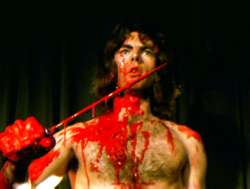 Up next is the condensed 1979 version of "Rabbit's Moon," the one seen by just about everyone prior to the release of these DVD sets. Though more incoherent than the longer '50s rendition, it does feature that knockout theme song and prefigures the explosive arrival of full-on music videos two years later.
Up next is the condensed 1979 version of "Rabbit's Moon," the one seen by just about everyone prior to the release of these DVD sets. Though more incoherent than the longer '50s rendition, it does feature that knockout theme song and prefigures the explosive arrival of full-on music videos two years later.
Easily the most complex and ambitious of Anger's projects, "Lucifer Rising" began filming in 1969 with heavy involvement from Bobby Beausoleil (still fresh off appearing Dave Friedman's The Ramrodder) as both the star (as Lucifer) and composer. However, Beausoleil's conviction and imprisonment for a Manson-mandated murder threw the project into chaos, with another actor subbing in for most of the Lucifer footage and a rift with Anger preventing the 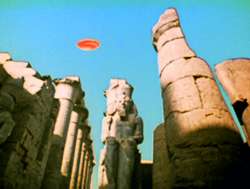 scoring for several years until they finally reconciled. Nevertheless, the end result is a stunning sensory experience if one is in a receptive mood. The film traces the worldwide use of the Lucifer ("bringer of light") figure from ancient Egypt through the crumbling castles of Europe, beginning with an appearance by future Performance director Donald Cammell as a green-skinned Osiris presiding over a sun ritual at the pyramids. Eventually completed in 1981, the film is really carried by Beausoleil's powerhouse psychedelic score, a real knockout in stereo on this DVD release. It's a long way from the doo-wop strains of Anger's earlier films but certainly no less striking. Incidentally, Jimmy Page stepped in between the original and final sessions to do the score, but it was never meant to be. For a full history of the music and a great sampling of the various versions over the years (as well as more info
scoring for several years until they finally reconciled. Nevertheless, the end result is a stunning sensory experience if one is in a receptive mood. The film traces the worldwide use of the Lucifer ("bringer of light") figure from ancient Egypt through the crumbling castles of Europe, beginning with an appearance by future Performance director Donald Cammell as a green-skinned Osiris presiding over a sun ritual at the pyramids. Eventually completed in 1981, the film is really carried by Beausoleil's powerhouse psychedelic score, a real knockout in stereo on this DVD release. It's a long way from the doo-wop strains of Anger's earlier films but certainly no less striking. Incidentally, Jimmy Page stepped in between the original and final sessions to do the score, but it was never meant to be. For a full history of the music and a great sampling of the various versions over the years (as well as more info 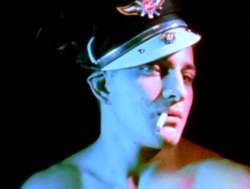 about the homemade prison conditions which resulted in its creation), try to track down the now-discontinued double CD soundtrack; it's worth the search.
about the homemade prison conditions which resulted in its creation), try to track down the now-discontinued double CD soundtrack; it's worth the search.
Finally, Volume II closes out with "The Man We Want to Hang," a 14-minute collection of paintings at a Crowley exhibit filmed by Anger with music by Anatol Liadov. It's more of an extra than a real short film, but completists will still find it interesting. The disc also includes another set of full Anger commentaries for each film, all filled with interesting tidbits. The "Scorpio Rising" commentary is probably the best, with plenty of amazing anecdotes about the apartment used for the opening scenes (and the flea-ridden cat who makes a cameo), the bikers' girlfriends being present during the filming of the bacchanale sequence, and the conditions which resulted in the unfortunate tragedy at the end. Great stuff all around. The "Lucifer Rising" commentary is also valuable as the only one in which Anger really digs in and explains the symbolism of the film, though he barely gives Beausoleil a mention. Also included is a restoration demo, an alternate soundtrack for "Invocation" from a related incomplete project, and a thick liner notes booklet with comments by Anger and appraisals by Scorses, Guy Maddin, and Gus Van Sant. The sets were later released as a dual-format Blu-ray and DVD set in the UK from the BFI.
![]()